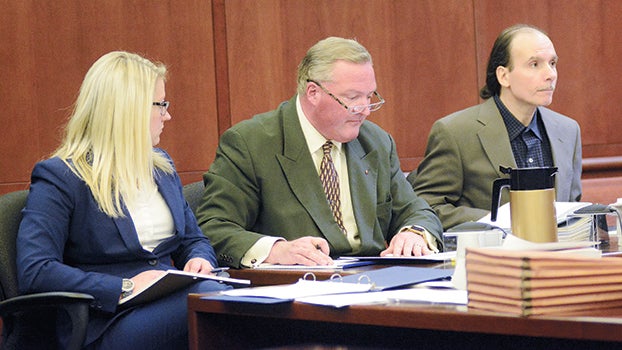Jury finds defendant guilty of first-degree murder
Published 9:19 am Friday, March 16, 2018

- From left, defense attorneys Jennifer Fields and Scott Sanford are pictured with defendant James Huffman, right, at the Berrien County Courthouse in Niles Tuesday. (Leader photo/KELSEY HAMMON)
NILES — After hearing testimony from 19 witnesses, jurors deliberated whether James Parker Huffman was guilty of first- or second-degree murder Thursday at the Berrien County Courthouse.
It took an hour and a half for jurors to reach their conclusion and they ruled that Huffman was guilty of murder in the first degree for killing his longtime girlfriend, Angela Cluver. Huffman will be sentenced for the crime by Judge Charles LaSata on April 30.
Over the course of the three-day trial, the court heard testimony from Huffman and Cluver’s friends, family, neighbors and coworkers, as well as a number of experts and police authorities.
Two final witnesses testified Thursday, including a police officer who helped to identify Cluver’s fingerprints and forensic pathologist Dr. Joseph Prahlow, who helped to conduct the body’s autopsy.

James Parker Huffman
In their closing statements, the defense and prosecution reviewed much of that testimony to formulate their arguments.
Assistant prosecutor Cortney O’Malley described Cluver’s final day before her death as one of horror. Manually strangled and left to decay in the laundry room of a home at 996 S. 14th St., O’Malley said this was not an act of love as the defense had argued.
She recalled the graphic photographs that jurors had witnessed that morning during testimony from Prahlow, who pointed out the bruising on Cluver’s neck and face, which was photographed during the autopsy.
“She had fractures to her cartilage and hyoid bone,” O’Malley said. “He [Huffman] told you he strangled her until he heard a pop.”
O’Malley also replayed portions of Huffman’s video-taped confession to police, in which he explains how he killed Cluver.
“He killed Angela Cluver. He intended to kill her and he planned it,” O’Malley said. “The only real discrepancy I see here is whether this was a brutal killing or an act of love, as [defense attorney Jennifer] Fields has characterized it.”
While O’Malley said testimony had shown that Cluver had problems, it had also shown that she was looking forward to life ahead. Testimony from a coworker indicated that Cluver was happy to go back to work at Modineer,after a temporary leave. Cluver was expected to return on Monday, July 24 — the day Huffman confessed to her killing and brought police to her body.
Cluver had also expressed that she was eager to help plan her daughter’s wedding and that money from disability was expected to arrive.
When police found Cluver, parts of her body, including her mouth and face, were wrapped in duct tape. While the defense told the court Huffman placed the duct tape on the victim so that he could easily move the body, O’Malley questioned why the victim’s face had to be taped to do so.
“Why did she have duct tape on her face?” O’Malley said. “What could be the scenario?”
O’Malley alleged that Huffman had woven a story for police to make himself look like a “tragic hero” and that items Huffman alleged to have used to attempt suicide were “conveniently” placed for police to find.
“Maybe the story went more like this: He’s controlling,” O’Malley said. “She doesn’t get to drive her own car or have her own phone or debit card and when she takes it accidentally, she panicks. Don’t let the defendant continue this story. Don’t let him manipulate you.”
In his closing, defense attorney Scott Sanford said witnesses recounted Cluver being happy Friday, July 21 — the day of her death. He said she may have been happy because she felt she had a way out of her struggles.
He reiterated the problems that Huffman and Cluver had been experiencing in the days leading up to her death. Sanford said testimony had shown that the couple struggled financially and had been having some health and family issues, too.
“Recently those financial issues started to close in around them,” Sanford said. “They were behind on the rent $2,600.”
Sanford said the issues had weighed heavily on the couple. He also said Huffman had made attempts to go through with his end of the alleged suicide pact.
Regardless of what Cluver’s wishes may have been, O’Malley said Huffman had still chosen to murder his girlfriend.
“You can’t kill somebody because they want to die,” O’Malley said.
Twelve jurors reviewed all the evidence. Two jurors were chosen randomly to be dropped from participating in the verdict, as is protocol.






